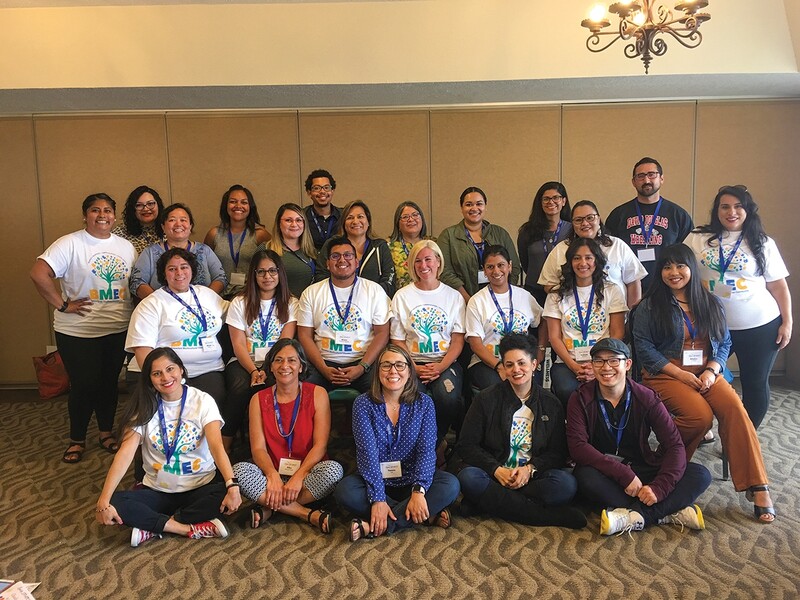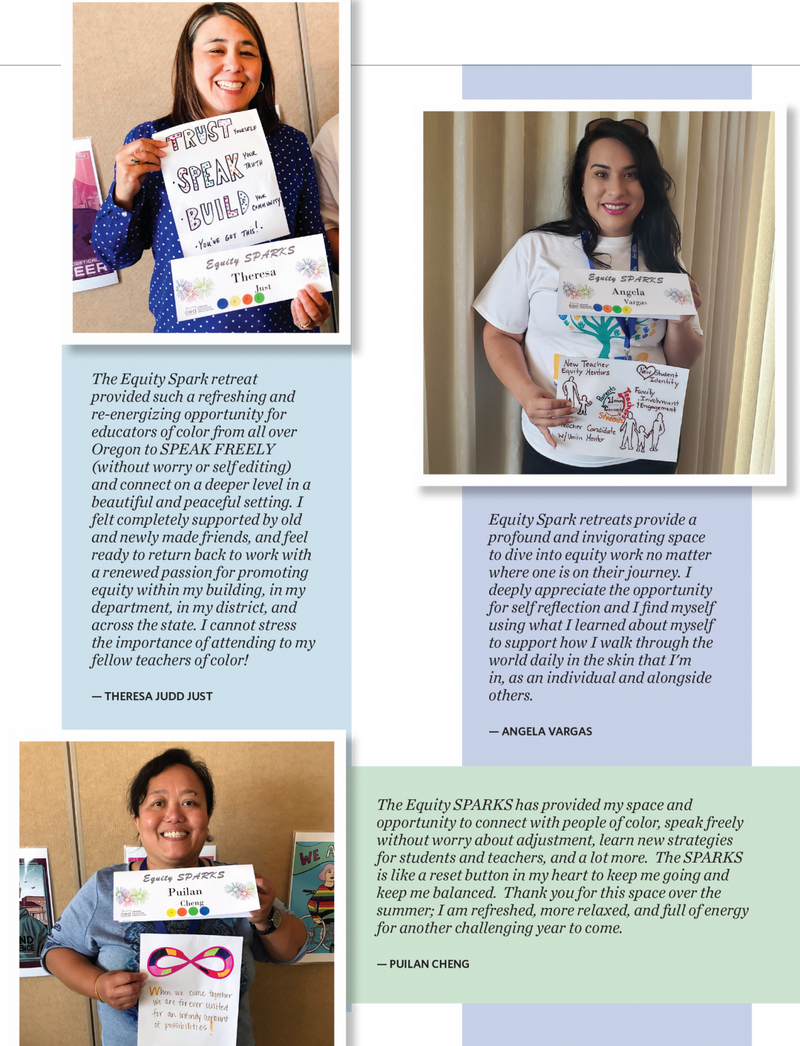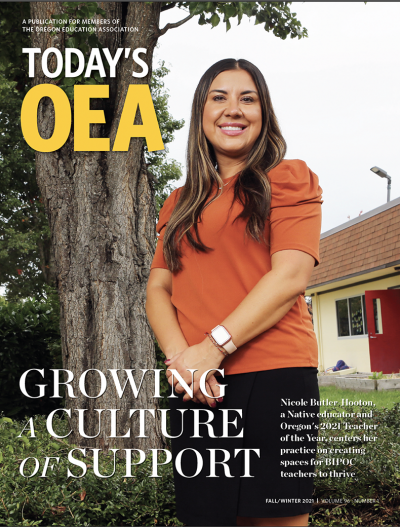Kelsey Blackwell, an activist, writer, and dancer, penned a beautiful article titled “Why People of Color Need Spaces Without White People.” In her writing, Blackwell figuratively inserted “breathing” throughout her powerful and sometimes painful piece. Why? Because it takes deep breathing to talk about equitable space as a person of color.
She writes, “Even if white people can’t access an embodied understanding of why PoC (People of Color) spaces are needed, they can still cultivate genuine compassion for our experience of needing them, and they can trust our voices enough to support these spaces. If the presence of spaces for people of color engenders discomfort, insecurity, or anger, I hope those emotions will be seen as an opportunity to look deeper within oneself to ask why.”

The first cohort of SPARKS retreat participants gathered together this summer to build affinity spaces for OEA members of color.
OEA has been on an intense and sustained internal and external exploration of equity, examining our underlying and perpetuating beliefs and practices that lead us away from living and thriving in an authentic, non-constructed world — a pluralistic world.
This authentic pluralistic world, however, is often overshadowed, marginalized and made invisible/inconceivable by a society that instead centers everything (including institutions, knowledge, values, and ways of doing) around one dominant culture. OEA courageously pursued and won a national grant to grow our work to deconstruct that paradigm and reconstruct an equitable one.
As an organization, OEA’s equity journey has been expertly guided by the Center for Equity and Inclusion — yet, it’s been made powerful and meaningful by the OEA members who are living, breathing equity champions every day.
These members have been blazing an equity trail in their classrooms, communities, and locals far in advance of OEA’s work. And these champions represent all races, creeds, genders, sexual orientations, abilities, and intersectionalities.
So, if equity work requires everyone, why do we need PoC spaces? What if we reframe that question so that we are instead asking: "Given our present society and the historical foundation for that society, what do equity champions need?" How can we best support the skills and heart of everyone to do that work collectively, if we do not meet the needs of individuals?
OEA believes these are the important questions and everyone has their part, both together and individually, to authentically join in solidarity to do this work.
the latest Oregon Educator Equity Report reveals that while 39.9 percent of our Oregon students are currently identified as culturally and linguistically diverse, only 11.2 percent of Oregon teachers are culturally and linguistically diverse (10.4 percent of Oregon teachers are identified as culturally diverse).... it does not come close to closing the gap or representing an authentic pluralistic society in our schools, and therefore, in our union.
The OEA Equity SPARKS retreats are focused on members of color so that we can create a safe and empowering space within the union environment to continue to do the collective work of equity.
In this revamped retreat setting, members are invited to join a small groupof 30 or less, at a destination spot where they can choose a grounding topic to focus on and engage in deep, healing, empowering and fun collegial growth together. Another obvious goal of the retreats is to connect our members of color to their union and help them build a wider community of support and leadership that expands to other areas of the state. The grant will allow OEA to conduct four to five of these retreats for the next three years. Our hope is that it will be sustained and grow so that OEA members of color are leading in their union and beyond.
Consider these obvious facts: the latest Oregon Educator Equity Report reveals that while 39.9 percent of our Oregon students are currently identified as culturally and linguistically diverse, only 11.2 percent of Oregon teachers are culturally and linguistically diverse (10.4 percent of Oregon teachers are identified as culturally diverse). This, in a way, is cause for celebration — for over three decades, we have long failed to bring the number of diverse Oregon teachers past single-digit percentages. But it does not come close to closing the gap or representing an authentic pluralistic society in our schools and, therefore, in our union.
What does this say to our students…to all students?
Are we checking off quota boxes to feel good about ourselves, or are we working to change why our schools and profession look like this? The challenge is not only in finding and hiring diverse teachers but in retaining them and building school environments that critically deconstruct non-equitable narratives and protocols and construct equitable, inviting and enriching pluralistic environments for students, staff and community members.

We cannot begin to elaborate on all the ways that educators of color must navigate systems, people, or the profession to be able to thrive and work to improve conditions for all students. Nor can we elaborate on the generational trauma, fatigue and physical damage that educators of color pay to be in this system and work for positive changes. Many of these educators, outside of their own families, have little opportunity to sit in affinity with others who are experiencing those same things... and to breathe.
Equity work has often been constructed with a privilege-centered approach, where awareness of the problems of inequity lies squarely on the deconstruction of pain and the cause of the pain. This has come at great emotional cost to every person of color engaged in the work and has failed to allow white allies to fully comprehend the importance of breaking down inequity, especially by those who benefit from it.
There is a growing awareness that the next generation of equity work must hold a place for affinity groups, to strengthen the skills and hearts of both people of color and white allies in becoming equity activists. Affinity group learning for white allies can support collective resolve and strengthen awareness and avoidance of the prevailing equity detours that can trap them time and time again. It can also sharpen their skills in being present and open as an ally.
It is true that, in this society, people of color and white allies have their own unique and separate work to do and need healing and sustenance to do it. It is also simultaneously true that collectively and as equal partners, all equity activists can harness their separate learning and move forward stronger together.
As Kelsey Blackwell was breathing her way through her brilliant article, she referred to the effects of our false society as “plaque that covered your being at birth—in its stickiness are challenges to your worth, intelligence, and humanity” and that being in a safe affinity space is “an important way to begin chipping away at this buildup” and allows us to “temporarily, leave that sticky inheritance at the door.” That is true for all of us, regardless of our race or ethnicity. That is our separate but necessary work — to get a deep cleaning, so to speak.
We do this challenging and important work so that together we can finally turn a corner in building a new inheritance for all our precious students. It is way past time and as the author, Arundhati Roy writes “Another world is not only possible, she is on her way. On a quiet day, I can hear her breathing.”
To learn more about SPARKS retreat opportunities and to work in affinity groups with fellow OEA members committed to equity, contact oea-gps@oregoned.org.

